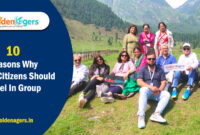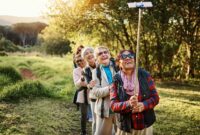Travel Ideas for Seniors: Embark on a journey filled with enriching experiences and unforgettable memories. This guide explores accessible destinations, budget-friendly options, and health considerations to ensure a safe and enjoyable trip tailored to the needs of senior travelers. We delve into practical tips for planning, including choosing suitable accommodations, transportation, and engaging activities that cater to varying mobility levels. Discover how to create a personalized travel plan that prioritizes comfort, safety, and cultural immersion, making your golden years even more golden.
From exploring accessible landmarks to finding budget-friendly travel packages and prioritizing health and wellness, we aim to empower senior travelers to confidently plan and enjoy their adventures. We’ll cover everything from choosing the right travel companions to utilizing support services, ensuring a smooth and stress-free journey. This comprehensive guide is your key to unlocking a world of possibilities, allowing you to explore new horizons and create lasting memories.
Accessible Travel Destinations
Planning a trip as a senior should be an exciting prospect, not a daunting one. Choosing accessible destinations ensures a comfortable and enjoyable experience, allowing you to focus on creating lasting memories. This section will highlight destinations known for their accessibility features and provide examples of senior-friendly accommodations and transportation options.
Accessible Travel Destinations with Accessibility Features and Recommended Activities
Selecting a travel destination with good accessibility is crucial for a smooth and enjoyable trip. The following table lists ten destinations known for their accessibility features, along with recommended activities suitable for seniors. Remember to always check specific locations and accommodations for the most up-to-date accessibility information before booking.
| Destination | Country | Accessibility Features | Recommended Activities |
|---|---|---|---|
| Amsterdam | Netherlands | Excellent public transportation with low-floor trams and buses, many wheelchair ramps, accessible restrooms in many tourist sites. | Canal cruises (many offer wheelchair access), exploring museums (many have wheelchair access and ramps), cycling on designated paths (rentals available). |
| San Francisco | USA | Accessible public transportation (BART, Muni), many wheelchair ramps, accessible restrooms in major attractions. | Riding cable cars (some offer wheelchair access), visiting Fisherman’s Wharf, exploring Golden Gate Park. |
| London | UK | Extensive accessible public transport (Tube, buses), many wheelchair ramps, accessible restrooms in major attractions. | Sightseeing on accessible bus tours, visiting Buckingham Palace, exploring museums (many have wheelchair access). |
| Paris | France | Improved accessibility in recent years, accessible metro lines, many wheelchair ramps, accessible restrooms in many tourist sites. | River Seine cruises (many offer wheelchair access), visiting iconic landmarks (many have ramps or lifts), exploring museums. |
| Rome | Italy | Increasing accessibility efforts, accessible buses and trams in some areas, accessible restrooms in some major attractions. | Visiting the Colosseum (accessible areas available), exploring Vatican City (some accessible routes), enjoying gelato in accessible cafes. |
| Kyoto | Japan | Generally good accessibility in major tourist areas, accessible trains and buses, increasing number of accessible restrooms. | Visiting temples and gardens (many offer wheelchair access), exploring traditional streets, enjoying tea ceremonies. |
| Barcelona | Spain | Improving accessibility, accessible metro lines, many wheelchair ramps, accessible restrooms in many tourist areas. | Walking along Las Ramblas (relatively flat), exploring Park Güell (some accessible areas), visiting Sagrada Familia (accessible areas available). |
| Sydney | Australia | Good public transport accessibility, wheelchair ramps, accessible restrooms in many tourist sites. | Ferry trips to Manly, exploring the Royal Botanic Garden, visiting the Sydney Opera House (accessible areas available). |
| Vancouver | Canada | Excellent public transportation with accessible buses and SkyTrain, many wheelchair ramps, accessible restrooms in major attractions. | Exploring Stanley Park, visiting Granville Island Market, enjoying the views from Grouse Mountain (accessible gondola). |
| Reykjavik | Iceland | Generally good accessibility in city center, accessible buses, many wheelchair ramps, accessible restrooms in many tourist sites. | Exploring the city center on foot (relatively flat), visiting Hallgrímskirkja church (accessible elevator), enjoying the geothermal pools (some offer wheelchair access). |
Senior-Friendly Accommodations
Choosing the right accommodation is vital for a comfortable and relaxing trip. Here are five examples of senior-friendly accommodations found across different global regions, emphasizing features that cater to the needs of older travelers.
These examples highlight the increasing availability of accommodations designed with senior travelers in mind. Many hotels and resorts are actively improving their accessibility features to cater to this growing market segment.
- The Langham, London (UK): Offers accessible rooms with features such as roll-in showers, grab bars, and emergency call systems. They also provide adapted transportation services.
- The Peninsula, Bangkok (Thailand): Provides spacious accessible rooms with wide doorways, adjustable beds, and emergency call buttons. Wheelchair-accessible transportation is available upon request.
- Fairmont Le Château Frontenac, Quebec City (Canada): Features accessible rooms with grab bars, roll-in showers, and ample space for maneuverability. They offer accessible transportation within the hotel and to nearby attractions.
- Four Seasons Hotel George V, Paris (France): Known for its commitment to accessibility, it offers spacious accessible rooms with features like adjustable height beds, lowered counters, and emergency call systems. Accessible transportation is also readily available.
- Park Hyatt Tokyo (Japan): Offers accessible rooms with features such as roll-in showers, grab bars, and emergency call systems. Wheelchair-accessible transportation is provided throughout the hotel and to nearby attractions.
Transportation Options for Seniors in Major Cities
Navigating a new city can be challenging, especially for seniors. Understanding the various transportation options available is essential for a stress-free experience. Here’s a comparison of public transport, ride-sharing services, and private car hire in three major cities.
The best option depends on individual needs and preferences. Factors to consider include the distance to be travelled, personal mobility, and budget.
New York City, USA: New York City boasts an extensive subway system, but accessibility varies across lines and stations. Ride-sharing services like Uber and Lyft are readily available, offering convenience, but can be expensive. Private car hire provides the most comfort and control, but is the most costly option.
London, UK: London’s public transportation, including the Tube and buses, is generally well-accessible, with many stations and buses equipped with ramps and elevators. Ride-sharing services are also prevalent, offering a convenient alternative. Private car hire provides a luxurious and comfortable experience.
Tokyo, Japan: Tokyo’s public transport system is efficient and generally accessible, with many stations and trains offering wheelchair access. Ride-sharing services are gaining popularity, providing an alternative to public transport. Private car hire is available, but navigating Tokyo’s traffic can be challenging.
Budget-Friendly Senior Travel
Planning a trip on a budget doesn’t mean sacrificing enjoyment, especially for seniors who often have more time than money. Smart planning and resourcefulness can unlock incredible travel experiences without breaking the bank. This section explores strategies and examples to help seniors travel affordably and comfortably.
Seven-Day Budget-Friendly Trip to Asheville, North Carolina
This itinerary focuses on Asheville, North Carolina, known for its stunning natural beauty, vibrant arts scene, and charming downtown area. It emphasizes free or low-cost activities and affordable accommodation choices.
Day 1: Arrival and exploration of downtown Asheville. Free walking tour to get acquainted with the city. Evening: Inexpensive meal at a local brewery. (Accommodation: Budget-friendly motel, $75/night).
Day 2: Visit the free Biltmore Estate gardens (admission to the house is extra, but the gardens alone are worth a visit). Picnic lunch. Afternoon: Explore the River Arts District, known for its studios and galleries (many offer free viewing). (Accommodation: $75/night)
Day 3: Hike a section of the Blue Ridge Parkway, enjoying stunning mountain views. Pack a lunch. Evening: Free live music at a local venue. (Accommodation: $75/night)
Day 4: Visit the North Carolina Arboretum (admission fee applies, but discounts may be available for seniors). Enjoy the beautiful trails and gardens. Evening: Cook a meal at your motel to save money. (Accommodation: $75/night)
Day 5: Explore the charming town of Black Mountain, a short drive from Asheville. Browse the local shops and enjoy the peaceful atmosphere. Lunch at a casual eatery. Afternoon: Relax and enjoy the scenery. (Accommodation: $75/night)
Day 6: Visit a local farmers market for fresh produce and local goods. Prepare a picnic lunch to enjoy in a park. Afternoon: Relax or revisit a favorite spot. Evening: Farewell dinner at a moderately priced restaurant. (Accommodation: $75/night)
Day 7: Departure.
Estimated Costs:
Accommodation (7 nights): $525
Food (7 days): $350 (assuming a mix of inexpensive meals and some prepared meals)
Transportation (rental car or using ride-sharing services): $200
Activities (Arboretum admission, etc.): $100
Total Estimated Cost: $1175 (This is an estimate and can vary depending on choices and deals found)
Comparison of Senior Travel Packages
The table below illustrates the price differences between all-inclusive resorts and independent travel for a seven-day trip for two seniors. Prices are estimates and can vary greatly depending on the specific location, time of year, and level of luxury.
| Package Type | Accommodation | Transportation | Activities & Meals | Total Estimated Cost (2 people) |
|---|---|---|---|---|
| All-Inclusive Resort (Luxury) | High-end resort | Airfare included | All meals and activities included | $8000 – $12000 |
| All-Inclusive Resort (Mid-Range) | Comfortable resort | Airfare included | Most meals and some activities included | $5000 – $7000 |
| Independent Travel (Budget) | Motels/budget hotels | Flights + local transportation (car rental or public transport) | Self-catering meals, free or low-cost activities | $2000 – $3500 |
| Independent Travel (Mid-Range) | Comfortable hotels/vacation rentals | Flights + local transportation | Mix of self-catering and restaurant meals, some paid activities | $3500 – $6000 |
Strategies for Saving Money on Senior Travel
Careful planning can significantly reduce travel costs.
Several strategies can help seniors save money on their travels:
- Utilize Senior Discounts: Many attractions, transportation services, and accommodations offer discounts for seniors. Always inquire about senior rates.
- Travel During the Off-Season: Prices for flights and accommodations are generally lower during the off-season (avoiding peak tourist times).
- Choose Affordable Accommodation Options: Consider staying in budget-friendly motels, hostels (if comfortable with that option), or vacation rentals (sharing with friends or family can further reduce costs).
- Pack Your Own Food and Drinks: Eating out for every meal can quickly add up. Packing snacks and some meals can save considerably.
- Take Advantage of Free Activities: Many destinations offer free or low-cost activities such as hiking, walking tours, visiting parks, and exploring local markets.
- Utilize Public Transportation: Public transportation is often cheaper than taxis or rental cars, especially in cities with good public transport systems.
- Book Flights and Accommodation in Advance: Booking ahead of time often leads to better deals and more choices.
Health and Wellness Considerations
Planning an international trip as a senior requires careful consideration of health and wellness. Prioritizing your well-being ensures a safe and enjoyable experience, minimizing potential risks associated with travel. This section outlines essential health precautions, insurance options, and strategies for creating a personalized health plan.
Necessary Health Precautions and Travel Insurance Options
Before embarking on any international journey, seniors should consult their physician for a comprehensive health check-up. This visit allows for the identification of any potential health risks and the development of a proactive plan to mitigate them. Discussions should include necessary vaccinations, recommended medications, and potential complications associated with the destination climate or activities planned. Furthermore, securing comprehensive travel insurance is crucial. Policies should cover medical emergencies, evacuations, trip cancellations, and lost luggage, offering peace of mind throughout the trip. Consider policies that specifically cater to the needs of senior travelers, often providing broader coverage for age-related health concerns. For example, a policy might cover pre-existing conditions or provide access to specialized medical care abroad.
Essential Medical Supplies and Medications
Packing a comprehensive medical kit is essential for senior travelers. This kit should include both prescription and over-the-counter medications, along with essential medical supplies. The importance of each item lies in its ability to address common travel-related ailments or manage pre-existing conditions effectively, avoiding potential disruptions to the trip.
- Prescription Medications: Pack a sufficient supply of all prescription medications, including extra to account for delays or unexpected circumstances. Keep medications in their original containers with labels clearly visible.
- Over-the-Counter Medications: Include pain relievers (ibuprofen, acetaminophen), anti-diarrheal medication, antacids, motion sickness remedies, and allergy medication. Consider any personal preferences or sensitivities.
- First-Aid Kit: A well-stocked first-aid kit should contain bandages, antiseptic wipes, antibiotic ointment, gauze pads, adhesive tape, and tweezers. Include any personal first-aid items you regularly use.
- Thermometer: A reliable thermometer is essential for monitoring fever or other temperature-related issues.
- Medications List: Carry a list of all medications, including dosages and potential side effects, for reference in case of emergencies. Share this list with travel companions.
Creating a Personalized Health and Wellness Plan
Developing a personalized health and wellness plan is crucial for senior travelers, especially those with pre-existing conditions or physical limitations. This plan should encompass several key aspects to ensure a smooth and safe journey. Consider consulting with your physician or a travel health specialist to tailor the plan to your specific needs. For example, individuals with heart conditions may require specific guidance on managing exertion levels during travel, while those with mobility issues need to plan for accessible transportation and accommodations. The plan should include details about medication schedules, potential health risks associated with the destination, emergency contact information, and a list of any allergies or sensitivities. A detailed itinerary can help identify potential challenges and allow for proactive adjustments to the travel plan. For instance, a senior with arthritis might opt for shorter walking distances and incorporate more rest periods into the daily schedule. Regular communication with family or friends back home can also provide an additional layer of support and security.
Engaging Activities for Seniors
Travel should be an enriching experience at any age, and for seniors, choosing activities that cater to varying levels of mobility and interests is key to a successful and memorable trip. The right activities can foster a sense of accomplishment, promote socialization, and create lasting memories. This section explores a range of engaging options designed to maximize enjoyment and cater to diverse preferences.
Engaging Activities for Seniors with Varying Mobility
Selecting appropriate activities is crucial for ensuring seniors enjoy their travels comfortably and safely. The following list provides a diverse range of options, considering both indoor and outdoor pursuits, and catering to different mobility levels.
- Gentle Walking Tours: Explore historical neighborhoods or scenic parks at a leisurely pace. Many cities offer guided walking tours specifically designed for seniors, with shorter distances and frequent rest stops.
- Museum Visits: Immerse yourselves in art, history, or science at a comfortable pace. Many museums offer accessible entrances, seating areas, and audio guides.
- Cooking Classes: Learn to prepare local dishes in a hands-on setting. This can be a fun, social activity, even for those with limited mobility.
- Botanical Garden Visits: Enjoy the beauty of nature without strenuous physical activity. Many botanical gardens offer accessible pathways and benches for resting.
- Relaxing Boat Trips: Enjoy scenic views from the comfort of a boat. Choose a cruise with accessible facilities and minimal walking required.
- Local Market Exploration: Immerse yourselves in the vibrant atmosphere of a local market, browsing unique crafts and tasting regional delicacies.
- Wine Tasting: Indulge in a relaxed wine tasting experience at a local vineyard. Many vineyards offer accessible facilities and comfortable seating.
- Indoor Swimming: Enjoy a gentle swim in a heated pool. This low-impact activity is beneficial for both physical and mental well-being.
- Chair Yoga or Tai Chi: Participate in gentle exercise classes designed for seniors, improving flexibility and balance. These can often be found in hotels or community centers.
- Attend a Local Performance: Enjoy a concert, play, or dance performance, providing a culturally enriching experience from a comfortable seat.
Culturally Enriching Experiences for Seniors
Travel provides opportunities for learning and engagement with different cultures. For seniors, culturally enriching experiences can broaden perspectives, stimulate the mind, and create lasting memories.
Examples include attending traditional music performances, visiting historical sites with guided tours that provide historical context, participating in local craft workshops (e.g., pottery, weaving), engaging with local artisans at markets, or taking a cooking class focusing on regional cuisine. These activities foster a deeper understanding and appreciation of the local culture and provide opportunities for meaningful interaction with the community.
Relaxation and Rejuvenation Activities for Senior Travel
Incorporating relaxation and rejuvenation activities into a senior travel itinerary is essential for maintaining well-being and ensuring a truly restorative experience.
Spa treatments, such as massages and aromatherapy, can alleviate stress and promote relaxation. Gentle yoga and meditation sessions can improve flexibility, reduce anxiety, and enhance mindfulness. Even simply incorporating quiet time for reading, reflection, or enjoying the scenery can contribute significantly to overall well-being. For example, a senior couple might choose to spend an afternoon at a spa, followed by a quiet evening enjoying a scenic sunset. The benefits extend beyond physical relaxation; they promote mental clarity and emotional balance, leading to a more enjoyable and fulfilling travel experience.
Travel Companions and Support
Choosing the right travel companions and securing adequate support can significantly enhance a senior’s travel experience, transforming a potentially stressful journey into a memorable adventure. The decision to travel solo or with companions involves weighing personal preferences against practical considerations related to safety, assistance, and overall enjoyment.
The advantages and disadvantages of solo versus accompanied travel for seniors differ greatly depending on individual needs and personalities. Solo travel offers unparalleled freedom and flexibility, allowing seniors to explore at their own pace and pursue their interests independently. However, it also presents potential challenges, particularly concerning safety and the need for self-reliance in unfamiliar environments. Traveling with a companion, on the other hand, provides built-in support, companionship, and shared responsibility. This can alleviate stress and enhance safety, but it might necessitate compromises on itinerary and pace to accommodate the needs of the travel partner.
Finding Reputable Travel Companions or Tour Groups
Locating reliable travel companions or joining suitable tour groups specifically catering to seniors requires careful research and consideration. Several avenues exist to facilitate this process. Senior-specific travel agencies specialize in organizing group tours designed with the needs and preferences of older travelers in mind. These agencies often incorporate accessible accommodations, slower paces, and activities tailored to the physical capabilities of their clientele. Online forums and social media groups dedicated to senior travel can connect individuals seeking travel companions with similar interests and mobility levels. These platforms offer opportunities to build rapport and assess compatibility before embarking on a trip together. Finally, consider contacting local senior centers or retirement communities; they may have organized group trips or be able to connect individuals interested in shared travel experiences.
Support Services for Senior Travelers
A range of support services is available to ensure the safety and comfort of senior travelers. Many airlines offer assistance with baggage handling, providing services for those with limited mobility. Wheelchair assistance is commonly available at airports and many tourist destinations, although pre-booking is usually recommended. For those with mobility challenges, renting mobility aids like walkers or wheelchairs is often possible at the destination or can be arranged in advance. Medical emergencies are a significant concern for senior travelers. Travel insurance policies specifically designed for seniors often cover medical evacuation and emergency medical care abroad. Additionally, carrying a comprehensive medical kit containing necessary medications and first-aid supplies is crucial. It is advisable to inform your healthcare provider of your travel plans and obtain any necessary vaccinations or medical advice. Finally, carrying a detailed itinerary and emergency contact information is essential for ensuring swift assistance in case of unforeseen circumstances. Consider registering your travel plans with your embassy or consulate.
Creating a Visual Guide for Senior Travelers
Visual aids are incredibly helpful for senior travelers, offering clear, concise information that’s easy to digest and remember. Well-designed infographics and brochures can significantly enhance the travel planning process, reducing stress and promoting a more enjoyable experience. This section details the creation of two such visual guides.
Infographic: Packing Light for Senior Travelers
This infographic would employ a visually appealing layout, perhaps using a suitcase as the central image. The left side would focus on “Pack These Essentials,” featuring icons representing lightweight, versatile clothing items. This section would emphasize practical considerations for seniors. For example, a picture of comfortable walking shoes would be accompanied by text advising choosing supportive footwear with good traction. Similarly, images of wrinkle-resistant clothing, lightweight scarves, and easily layered garments would be paired with brief descriptions of their benefits. The right side would highlight “Leave These Behind,” using images of heavy items like bulky sweaters, unnecessary toiletries, and multiple pairs of dress shoes, alongside concise explanations for why they’re not recommended for senior travelers. The color scheme should be calming and easy on the eyes, perhaps using soft blues and greens. The font should be large and easy to read. The overall design should be uncluttered and straightforward.
Brochure: The Benefits of Senior-Friendly Travel
This brochure would adopt a tri-fold design. The front panel would feature a captivating photograph of seniors enjoying a relaxing activity in a beautiful location, perhaps a scenic view or a pleasant outdoor setting. The headline would be simple and inviting, such as “Discover the World, Your Way.” The inside left panel would highlight “Comfort and Ease,” with descriptions of accessible accommodations, comfortable transportation options, and well-paced itineraries. This section could include images of spacious hotel rooms, comfortable buses, and relaxing spa treatments. The inside right panel would focus on “Safety and Security,” featuring information on travel insurance, emergency contact information, and readily available medical assistance. Images of clearly marked exits, accessible restrooms, and medical kits could be included. The back panel would showcase “Enriching Experiences,” detailing opportunities for cultural immersion, relaxation, and social interaction. Pictures of engaging activities such as guided tours, gentle hikes, and social gatherings would complement the text. The overall design would emphasize a calming and reassuring atmosphere, using a warm color palette and easy-to-read fonts. High-quality photography would be essential to convey the appeal of senior-friendly travel.
Wrap-Up
Planning a fulfilling and memorable trip as a senior traveler is achievable with careful consideration and the right resources. By focusing on accessible destinations, budget-friendly strategies, and prioritizing health and wellness, you can craft a personalized itinerary that caters to your unique needs and preferences. Remember, travel is an enriching experience at any age, and with proper planning, your senior adventures can be both exciting and rewarding. Embrace the journey and create lasting memories that will stay with you for years to come.




